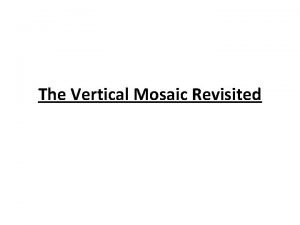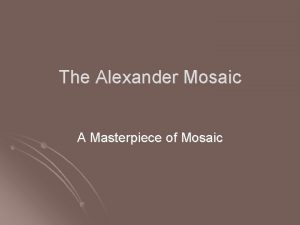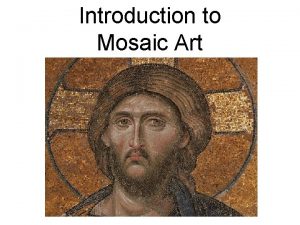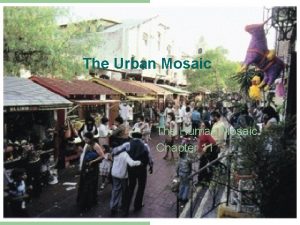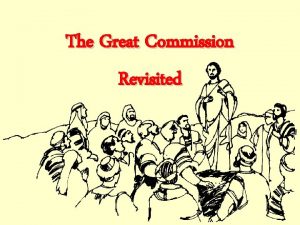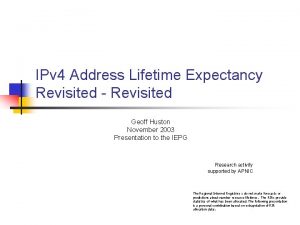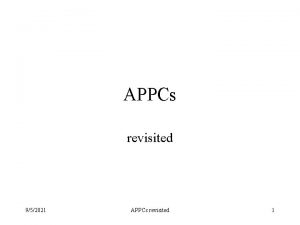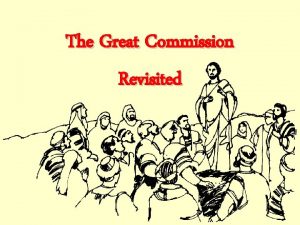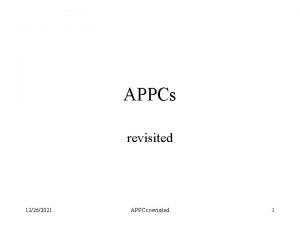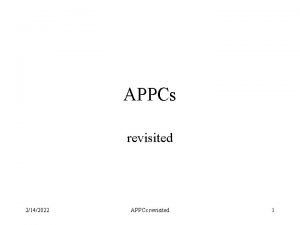The Vertical Mosaic Revisited Vertical Mosaic a term










































![• SOCIAL STRATIFICATION AND INEQUALITY REFERS TO DOMINANT- SUBORDINATE INTERACTION === [3] THE • SOCIAL STRATIFICATION AND INEQUALITY REFERS TO DOMINANT- SUBORDINATE INTERACTION === [3] THE](https://slidetodoc.com/presentation_image_h/be19f8a50fc13c76d96533b55a806284/image-43.jpg)


- Slides: 45

The Vertical Mosaic Revisited

• Vertical Mosaic, a term used by sociologist John Porter to convey the concept that Canada is a mosaic of different ethnic, language, regional and religious groupings unequal in status and power. .

• Porter published his book, Vertical Mosaic: An Analysis of Social Class and Power in Canada, in 1965.

• "Mosaic" is often contrasted with the American concept of "melting pot. " • The Canadian John Murray Gibbon, in his book The Canadian Mosaic (1938), disapproved of the American melting-pot policy,

• According to which immigrants and their descendants were discouraged from maintaining close ties with their countries and cultures of origin and instead were encouraged to assimilate into the American way of life.

• Many Canadians pointed with pride to the alternative Canadian policy of encouraging immigrants and their descendants to maintain important aspects of their ancestral cultures.

• Porter's view was that in income, occupation and education, this supposedly beneficial policy worked to the advantage of some ethnic groups and to the disadvantage of others. • Porter's book revealed that some groups (eg, those of British origin) have better incomes, education and health than others (eg, those of eastern and southern European origin).

• Native Indian and Inuit people were the most disadvantaged. • According to Porter, this vertical arrangement also applied to power and to influence in decision making.

• In the bureaucratic, economic and political spheres, those of British origin are overrepresented among the elites. • Since 1965 several studies have shown that the picture sketched by Porter has been modified only slightly

• , ie, there has been some lessening of the economic gap between ethnic groups, and people of French origin are better represented in the political and bureaucratic spheres.

• The economic elite, still dominated by those of British origin, has changed very little. • The book earned Porter the prestigious American Sociological Assn's Mc. Iver Award.

• When The Vertical Mosaic first appeared in 1965, it became an instant classic. • Its key message was that Canada was not the classless democracy it fancied itself to be. In fact, Canada was a highly inegalitarian society comprising a ‘vertical mosaic’ of distinct classes and ethnic groups.

• This collection of papers by five of Canada’s top sociologists subjects John Porter’s landmark study to renewed scrutiny and traces the dramatic changes since Porter’s time – both in Canadian society and in the agenda of Canadian sociology. • Based on papers written for a conference held in commemoration of the thirtieth anniversary of. The Vertical Mosaic’s publication, the five essays revisit the central themes of the original work, including gender and race inequality; citizenship and social justice; and class, power, and ethnicity from the viewpoint of political economy. An introduction by the editors provides a historical biography of Porter and discusses his influence on Canadian sociology.

• For Some, the Racial `Mosaic' Pales at Top. By Howard Schneider Washington Post Foreign Service Monday, December 29, 1997; Page A 01

• In a nation that prides itself on diversity and visualizes its society as a "mosaic" of equal pieces, the distribution of political, social and economic influence is still largely held by those of European heritage.

• "Canadians say they believe in the mosaic, but some of the tiles have never seen a polish from the day they were put on the wall, " said Jolly. • there is a lot of lip service, but in matters of race you are never quite sure of your place. " • .

• It can be seen in the country's largely white governing institutions – the handful of nonwhite faces, for example, among the 56 recently elected city council members in Toronto, a city some estimate to be more than 40 percent nonwhite – or in the lack of racial diversity in the nation's corporate head offices.

• In the Financial Post magazine's recent survey of Canada's top 200 corporate chief executives, only seven are nonwhite. Of those, five are Japanese or Chinese natives running subsidiaries of Japanese- or Chineseowned companies; the other two are Asians who built their own businesses in Canada

• It can be seen in poverty, wage and job statistics that in some ways mirror those of the United States, with members of so-called visible minorities – people of color – more likely to be out of work, out of school and living in poverty than white Canadians.

• "Among men, among the native-born, the ethnic earnings gaps are pretty similar between Canada and the United States, " with differences of more than 15 percent in some cases between what white and nonwhite Canadians earn for similar work, said Krishna Pendakur, a professor at Simon Fraser University in Vancouver who recently completed a study of the issue.

• What is clear, however, is that Canada's multicultural composition is increasingly a multiracial one as well. The fastest growing portion of Canada's population is its native Indian community, and immigration patterns have shifted away from Europe in favor of East Asia, the Indian subcontinent, Africa and the West Indies. In 1996, the number of non-European immigrants living in Canada surpassed the number of European immigrants for the first time. • That is not readily apparent, however, in the country's upper echelons. • When Jamaican-born politician Alvin Curling takes his seat in Ontario's provincial legislature, he is one of only two nonwhites, a fact that makes him envious of the influence and numbers that black U. S. politicians have achieved despite their country's history of more virulent racism.

• • When Fo Niemi watches the all-white casts of Canada's top political satire shows, scans the all-white audiences at political debates staged by the CBC or looks at the all-white staffs of Quebec's major broadcasters, he said, he sees a Canada much different from the one he experiences on the streets of Montreal. "It is very glaring, " said Niemi, executive director of the Center for Research Action on Race Relations. "When it comes to real inclusion – real integration, real presence in decision-making positions – we still have a fairly long way to go. " The story varies across the country. British Columbia, with a critical mass of Asian and Indian immigrants, has elected three nonwhite members of Parliament who are also junior members of the federal cabinet. There are prominent Asian entrepreneurs and broadcasters, local and provincial politicians, and philanthropists whose names grace academic and other public buildings that they helped fund. According to Pendakur's research, wage differentials are smaller in British Columbia than in the other provinces. At the other extreme, there is Quebec, where diversity in the upper ranks of society is measured more in terms of who speaks English and who speaks French. The province's political and business elite is all white, and that homogeneity, Niemi said, extends through such institutions as the judiciary, even to local politics in Montreal, despite that city's multi-hued population.

• Nor is the country free of the type of institutional issues that the United States has addressed with affirmative action. Over the past year, the federal Health Department was cited for bias in its hiring and promotion and ordered to adopt measures to right the balance. In Toronto recently, the city firefighters' union was accused of discriminating against visible minorities and women. • Ujjal Dosanjh, the attorney general of British Columbia, said his experience shows both Canada's promise as a multicultural and multiracial society and the degree to which its reality still falls short. Personally, he has made it from the Punjab countryside to the second-most-powerful position in British Columbia and feels accepted representing a parliamentary district that is a mix of white, Indian and Chinese Canadians. • On the other hand, he said that British Columbia, as the focus of Asian immigration for many decades, may be more open to the advancement of racial minorities into leadership positions – and thus not reflective of the country as a whole. At meetings with his provincial counterparts and their staff, he said, it is obvious how far Canada needs to go.

• The leadership of Canada is "very, very European. . At the end of the 20 th century, we are still not reflective of the diversity of the country, " Dosanjh said. He said he routinely raises the lack of racial minorities in Canada's judicial institutions when he meets with his colleagues. He said his current focus is the prime minister's next appointment to the Supreme Court, a choice typically made with an eye toward regional and French. English linguistic balance. • "The aboriginals have been here for 5, 000 years. The Indo-Canadians have been here 100 years. . We are now including European diversity on the Supreme Court. That is wonderful, " Dosanjh said. "In a very polite but pointed way, I have asked. . `When are you going to include the first visible minority appointment? ' " • Different Histories of Slavery • Both Canada and the United States are immigrant nations, but discussions of race and ethnicity in the two countries have proceeded differently.

• While much of the dialogue in the United States, for example, deals with the effects of slavery – a discussion that spans 130 years of Jim Crow laws, civil rights protests and affirmative-action debates – Canada has no such legacy to confront. Slavery was in decline here during the early 1800 s, and the British government abolished it in 1834. By the time of the American Civil War, Canada was a haven for escaped slaves as the terminus of the Underground Railroad. • Today, there are only a few hundred thousand blacks among Canada's 30 million people, and, because of the countries' differing histories, there is far less of a tendency here to analyze public policy in terms of race.

• • • In addition, the waves of European immigration that transformed many U. S. cities over the last century were not felt as fully in Canada until the 1950 s and 1960 s, when arrivals from such countries as Italy and Germany began changing Canada's predominantly Anglo-French composition. As recently as the 1930 s, it was estimated that 80 percent of Canadians were of either British or French extraction. It was during that time, as well, that Canada cast itself as a "multicultural" country and confirmed the mosaic as its guiding idea. In large part, that policy derived from the issue that long has governed so much of Canada's politics – competition between the country's English and French founding populations, which have tussled for control of the country since colonial days. A special commission on biculturalism and bilingualism in the 1960 s confirmed the equal status of founding peoples and languages, and the mosaic was a handy device to describe a situation in which two cultures coexisted while maintaining their identities. With immigration from non-English and non-French societies then on the rise, that debate was expanded to endorse multiculturalism and so include other nationalities in the mosaic as well, said political scientist Martin Lubin, a Canada expert at the State University of New York.

• • • "It was a convenient political add-on to the emergent bicultural mythology, " Lubin said, and one that was consistent with Canada's sense of itself as a fair and largely classless nation. However, when researchers started studying the mosaic, they deemed it – as John Porter said in a work considered a classic of Canadian sociology – to be "vertical, " with a power structure at the top that was still largely English and French, and people of other origins arrayed in various strata beneath them. "Segregation in social structure, to which the concept of the mosaic or multiculturalism must ultimately lead, can become an important aspect of social control by the charter group, " he wrote in his 1965 book, "The Vertical Mosaic. " "The very small ethnic representation in our elite groups, " he wrote, "suggests that the chances of achieving the top positions are few. " Porter's research focused largely on the fate of other European nationalities subordinated to the dominant English and French cultures. Thirty years later, the situation he described has changed. There are many Italians, Germans and other non-English, non-French Europeans in positions of authority. When Canadians speak of the success of their multicultural experiment, it is diversity on this scale – not exclusively multiracialism – that they refer to.

• The issue the country confronts today, researchers, politicians and community activists say, is whether people of color will also rise to the upper levels of Canadian society as they come to represent a larger and larger portion of the population. • To political scientist Lubin, the mosaic is still vertical and the chances of its leveling over time are in doubt. "The multicultural mythology enables people to come away with a series of beliefs about what is happening, which is not really happening as rapidly or thoroughly as the official mythology would have us believe, " he said. • Avoiding the `American Model' • However, to Canadian officials like Hedy Fry, the secretary of state for multiculturalism and a member of Parliament from British Columbia, there is no reason to think that immigrants of color will not flourish, just as the European immigrant groups did before them.

• As Canada's nonwhite groups expand their numbers, with each generation building on the success of the last, she says, she is confident that will happen. Even focusing on race, she contended, is an American habit that is not as relevant to a country without the United States' difficult history of institutionalized racial segregation. Even though blacks, for example, form a small percentage of Canadian society, a leading jurist like Julius Isaac can rise to become the top judge of the country's federal court system.

• Fry also pointed to herself as an example, a native of Trinidad elected to the House of Commons and a junior member of the cabinet. • "Twenty-five t • o 30 years ago, we began to experiment with a different model, " she said. "The American model did not work very well. It created people who were angry that they had to give up who they were. " • "We have the most successfully integrated country in the world, " said Thomas d'Aquino, head of the Business Council on National Issues, an influential coalition of Canada's largest companies. "The politics of color and the politics of race have not played as big a role. "

• According to a recent membership brochure, only three of the business council's 148 members are nonwhite, and each runs a subsidiary of a Japanese corporation. But d'Aquino said he fully expects the council's membership to diversify over time. Until then, he said, evidence of Canada's multiracial success can be seen in its low levels of racial tension and in the absence of the type of desperate and desperately violent ghettos found in many U. S. cities.

• Some analysts, however, are starting to wonder about that issue as well. Tim Rees, a human resources analyst for the metropolitan Toronto government, points out that there areas of Toronto where immigrants of color cluster and where the foreign- and native-born face the same employment and educational issues – fewer jobs, lower pay and higher dropout rates – that cripple some American neighborhoods. In smaller cities such as Winnipeg, meanwhile, high unemployment and widespread drug use among native-born Canadians has led to the formation of sometimes violent street gangs. • How Canada addresses such issues, Rees said, will determine whether the promise of multiculturalism is realized. • "We've managed to avoid directly confronting that, and we can continue to remain living in this illusion that we are different from south of the border, or different from the United Kingdom, and that is what multicultural policy has allowed us to do, " Rees said. "It's a bit of a fool's paradise. . What happened in Detroit could happen in Toronto, and it will happen very quickly, and we won't be able to recover after the fact. "

Ethnic Inequality in Canada: Economic and Health Dimensions Ellen M. Gee 1 Karen M. Kobayashi 2 Steven G. Prus 3 2007 • CONCLUSION Our findings are consistent with existing literature on ethnic inequalities in Canada. We find that persons with a non. English mother tongue are at an economic disadvantage. This is especially the case for recent immigrants with a mother tongue other than English or French -- our data analyses in fact show that they are among the most disadvantaged in Canadian society

• . We also find that certain visible minority and Aboriginal groups tend to be economically disadvantaged while others are economically advantaged (e. g. , those of Chinese origin are the most financially secure of the groups measured here) compared to persons of European origin, even when gender, age, marital status, and education differences are taken into account.

• That is, visible minorities are a diverse group with regard to economic outcomes. By contrast, variation in economic well-being between European groups (British, French, and NW and SE European) is relatively minor. Overall, these findings lend support to the argument that the economic disparities faced by ethnic and racialized groups are partly attributable to racial discrimination in Canadian society.

• We also find significant differences in health status and health care utilization according to country of birth/immigrant status and language. However, unlike economic outcomes, recent immigrants (especially from Asia) are advantaged in health outcomes compared to Canadian-born persons.

• This advantage completely disappears with time - as the number of years in Canada increases, the likelihood of experiencing a chronic health condition increases. Paradoxically, they are less likely to report having a physical check-up and, for older women (especially Asian- 24 born women), a mammogram within the last year compared to their Canadian-born counterparts. These patterns are observed for those who speak French only.

• In interpreting the health inequality findings, the key emergent issue is the clash between the ethno-cultural values and beliefs of foreign-born and perhaps Frenchspeaking Canadians and the health care system. Although it is difficult to provide insights into this relationship given the paucity of research in this area, it is important to acknowledge the contribution of our analysis to the literature; primarily, that cultural characteristics, regardless of socio-structural and demographic factors, are salient predictors of health.

• Macleod and Eisenberg’s (Chapter 2) suggestion that a cultural framework or lens is needed in order to fully examine the outcomes of social inequality in Canadian society is clearly supported by our findings in the economic and health domains. Indeed, the results indicate that the cultural variables of ethnicity, immigrant status, and mother tongue are related to economic well-being, health status, and health care utilization in Canada; specifically, Aboriginal, visible minority, and non-charter language-speaking identifications are tied to deficits in cultural capital (i. e. , skills, qualifications, group memberships).

• Finally, an interesting and important finding from the study is that much of the economic inequality according to type of occupation (occupational concentration) can be attributed to gender rather than ethnicity; that is, the Canadian labour force continues to be more gender- than ethnically-differentiated. Evidence of this gendered division in the labour force can be found in Fortin and Schirle’s (Chapter 10) study on changes in income inequality over time. Using Survey of Consumer Finances data, they conclude 25 that income inequality (as measured by weekly earnings) for men has increased more than for women over the same period, and that this has occurred for different sociostructural reasons. Given the significance of both gender and ethnicity as predictors of economic well-being, future research should examine the intersection between the two identity markers and their relationship to social inequality.

• • WHAT DID WE LEARN ABOUT CULTURE THAT IS SPECIFIC TO CANADA? SOCIOLOGICAL THESIS: CANADIAN SOCIETY IS A “VERTICAL MOSAIC” PRODUCED BY THE INTERRELATIONSHIP BETWEEN CULTURE, POWER AND IDEOLOGY CANADA COMPRISES AN ETHNO-RACIAL HIERARCHY: THE INTERACTION BETWEEN CULTURE, POWER AND IDEOLOGY IS THE BASIS FOR “SOCIAL STRATIFICATION” (POSITION, RANK, LAYER, PECKING ORDER ) IN “OUR” SOCIETY ******SOCIETY IS A SYSTEM OF “GRADUATED PRIVILEGE”---SOCIAL RANKING// LAYERING //“PECKING ORDER” // “TOTEM POLE” IN SOCIETY == IS AN EXTENSION OF CULTURAL GROUP INTERACTION, EMBEDDED AND ENFORCED BY POWER, AND JUSTIFIED BY IDEOLOGY ****BECAUSE IT FOCUSES ON THE UNEQUAL DISTRIBUTION OF VALUED RESOURCES * SOCIAL STRATIFICATION IS THE CORNERSTONE OF SOCIOLOGY. SOCIAL STRATIFICATION CAN BUT STUDIED BECAUSE IT REFERS TO PERSISTENT PATTERNS OF SOCIAL INEQUALITY WITHIN SOCIETY == THE WAY THAT WEALTH, POWER AND PRESTIGE IS DISTRIBUTED.

• • PART II --- THE NATURE OF SOCIAL STRATIFICATIONAND THE STUDY OF SOCIAL INEQUALITY: • 3) THE STUDY OF SOCIAL STRATIFICATION • A) EVERY SOCIETY CAN BE DIVIDED INTO LAYERS OR HIERARCHIES THAT CAN BE RANKED ACCORDING TO CERTAIN CRITERIA IN ASCENDING OR DESCENDING ORDER. THIS SUGGESTS THAT INEQUALITY IS NOT RANDOM OR FLEETING, BUT IS PATTERNED AND PREDICTABLE AND TENDS TO CLUSTER AROUND CERTAIN DEVALUED CATEGORIES RELATED TO RACE OR ETHNICITY}}} === [1] THE HIERARCHICAL ARRANGEMENT OF SOCIAL STRATA IN A SOCIETY == A HIERARCHY OF POSITIONS THAT HAVE UNEQUAL PROPERTY, POWER AND PRESTIGE(3 PS). [2]
![SOCIAL STRATIFICATION AND INEQUALITY REFERS TO DOMINANT SUBORDINATE INTERACTION 3 THE • SOCIAL STRATIFICATION AND INEQUALITY REFERS TO DOMINANT- SUBORDINATE INTERACTION === [3] THE](https://slidetodoc.com/presentation_image_h/be19f8a50fc13c76d96533b55a806284/image-43.jpg)
• SOCIAL STRATIFICATION AND INEQUALITY REFERS TO DOMINANT- SUBORDINATE INTERACTION === [3] THE CONCEPT OF A MINORITY AND MAJORITY GROUP DOES NOT REFER TO “NUMBERS” OR “STATISTICAL PROPORTIONS” — BUT RATHER — TO “POWER RELATIONS” == [4] SOCIAL STRATIFICATION MEASUREMENT “TOOLS”== “SOCIAL ECONOMIC STATUS” VERSUS “SOCIAL CLASS”

• • • B) WHY IS SOCIAL STRATIFICATION CONSIDERED THE CORNERSTONE OF SOCIOLOGY? BECAUSE IT THE MAIN FACTOR DETERMINING HOW SOCIETY WORKS. SOCIAL STRATIFICATION IS CONSIDERED THE CORNERSTONE OF SOCIOLOGY BECAUSE EVERY SOCIETY IS STRATIFIED IN SOME WAY --- AFFECTING THE SOCIAL RELATIONS OF ITS MEMBERS. SOCIAL STRATIFICATION IS CONSIDERED THE CORNERSTONE OF SOCIOLOGY BECAUSE SOCIETY IS DIVIDED INTO STATA/ LAYERS IN DECENDING AND ASCENDING ORDER, WHICH REVOLVE AROUND DIFFERENCES CONSIDERED TO BE CONSEQUENTIAL LIKE RACE, ETHNICITY, CLASS AND GENDER --- AND DETERMINE ACCESS TO SOCIETY'S RESOURCES. ALL SOCIETIES ARE STRATIFIED ON THE GROUNDS OF SOME SOCIAL CRITERIA, AND SOCIOLOGY STUDIES HOW SOCIETIES ARE STRATIFIED BY FOCUSING ON THE UNEQUAL DISTRIBUTION OF VALUED RESOURCES EVERY SOCIETY CAN BE DIVIDED INTO LAYERS OR HIERARCHIES THAT CAN BE RANKED ACCORDING TO CERTAIN CRITERIA IN ASCENDING OR DESCENDING ORDER. THIS SUGGESTS THAT INEQUALITY IS NOT RANDOM OR FLEETING, BUT IS PATTERNED AND PREDICTABLE AND TENDS TO CLUSTER AROUND CERTAIN DEVALUED CATEGORIES RELATED TO RACE OR ETHNICITY. SOCIAL STRATIFICATION IS CONSIDERED THE CORNERSTONE OF SOCIOLOGY BECAUSE IT DEALS WITH THE SOCIAL CONSTRUCTION OF SOCIETY AS A HIERARCHY OF POWER, PROPERTY AND PRESTIGE. SOCIAL --- I. E. , A HIERARCHY OF POSITIONS THAT HAVE UNEQUAL PROPERTY, POWER AND PRESTIGE (3 PS). SOCIAL STRATIFICATION IN SOCIETY RESULTS IN "THE HIERARCHICAL ARRANGEMENT OF GROUPS" BASED ON THEIR CONTROL OVER RESOURCES FINALLY, SOCIAL STRATIFICATION ALSO IMPACTS ALL OTHER DIMENSIONS OF SOCIOLOGICAL INQUIRY == SOCIAL STRUCTURE, SOCIAL ORDER, SOCIAL CONFLICT AND SOCIAL CHANGE.

• • • • • • • • • • 3) SOCIAL INEQUALITY HOW DO CERTAIN HUMAN DIFFERENCES COME TO REGULARLY HAVE SIGNIFICANT CONSEQUENCES FOR THE LIVES THAT WE ARE ABLE TO LEAD IN SOCIETY? ==è STRUCTURED AND RECURRENT PATTERNS OF INEQUITABLE GROUP RELATIONS [*****DOMINANT-SUBDOMINANT INTERACTION]. SOCIAL INEQUALITY – IS CHARACTERIZED BY THE EXISTENCE OF UNEQUAL OPPORTUNITIES AND REWARDS FOR DIFFERENT SOCIAL POSITIONS OR STATUSES WITHIN A GROUP OR SOCIETY. ALL CONTEMPORARY SOCIOLOGISTS AGREE ======> INEQUALITY IS ABOUT ENTITLEMENTS: THAT IS, WHO GETS WHAT, HOW AND WHY? MEASUREMENTS(? ) (A) INEQUALITY OF CONDITIONS =======>{ECONOMIC PRIVILEGE OR THE MATERIAL DISTRIBUTION OF REWARDS}; AND/OR (B) INEQUALITY OF OPPORTUNITIES ======> {“LIFE CHANCES” – REFLECTED IN SUCH MEASURES AS THEIR LEVEL OF EDUCAITON, HEALTH STATUS, NUTRITION, AND TREATMENT BY THE JUSTICE SYSTEM} IN TERMS OF THESE MEASURES, CONTEMPORARY SOCIOLOGISTS TEND TO AGREE THAT ETHNICITY AND RACE AND GENDER ARE KEY STATUS-INEQUALITY SYSTEMS 4) EMPLOYMENT EQUITY AND AFFIRMATIVE ACTION: MECHANISMS FOR REDRESS OF SOCIAL STRATIFICATION AND INEQUALITY EMPLOYMENT EQUITY: A SET OF PRACTICES DESIGNED TO IDENTIFY AND ELIMINATE DISCRIMINATORY PRACTICES THAT CREATE UNFAIR OR UNEQUAL EMPLOYMENT OPPORTUNITIES AND TO PROVIDE EQUITABLE OPPORTUNITIES IN EMPLOYMENT FOR DESIGNATED GROUPS. A) EMPLOYMENT EQUITY MEANS MORE THAN TREATING PEOPLE IN THE SAME WAY; IT REQUIRES SPECIAL MEASURES AND THE ACCOMODATION OF DIFFERENCES. B) EMPLOYMENT EQUITY REFERS TO THE QUALITY OF RESULTS NOT THE EQUALITY OF TREATMENT. THE THREE PURPOSES OF EMPLOYMENT EQUITY LEGISLATION: [A] TO "ELIMINATE SYSTEMIC DISCRIMINATION" (INSTITUTIONAL BARRIERS THAT LIMIT ACCESS TO VALUED RESOURCES FOR REASONS OTHER THAN ABILITY) IN ORDER TO TAKE ADVANTAGE OF THE MOST CAPABLE. [B] TO "REMEDY" THE EFFECTS OF "PAST DISCRIMINATION", AND [C] TO ACHIEVE A "REPRESENTATIVE WORKFORCE"; THE FOUR DESIGNATED GROUPS FOR EMPLOYMENT EQUITY PURPOSES ARE: [A] ABORIGINAL PEOPLES, [B] PERSONS WITH DIABILITIES, [C] MEMBERS OF VISIBLE MINORITY GROUPS, [D] AND WOMEN THE RELATION BETWEEN EMPLOYMENT EQUITY AND AFFIRMATIVE ACTION IN CANADA: [A] EMPLOYMENT EQUITY REPLACED AFFIRMATIVE ACTION INITIATIVES 13 JANUARY 1986. [B] CHANGE THE FOCUS FROM "QUOTAS" TO "TARGETS" BASED ON PERCENTAGES. (THE THEORY OF "TARGETS" IS THAT IT AVOIDS "REVERSE DISCRIMINATION" AND "PREFERENTIAL TREATMENT". ) [C] (SEEN POSITIVELY AS) A SYSTEMS-BASED STRATEGY AND A RESULTS-ORIENTED PROCESS. [D] (THEREFORE) NEUTRALIZES EMPLOYMENT SYSTEMS THAT DISFAVOR DESIGNATED GROUPS. … AFFIRMATIVE ACTION: THE SET OF PUBLIC POLICIES AND INITIATIVES DESIGNED TO HELP ELIMINATE PAST AND PRESENT DISCRIMINATION BY INCREASING OPPORTUNITIES TO INDIVIDUALS AND GROUPS WHO HAVE HISTORICALLY BEEN EXCLUDED FROM FULL PARTICIPATION IN AND ACCESS TO SUCH AREAS AS EMPLOYMENT AND EDUCATION. A) AFFIRMATIVE ACTION WAS FIRST CONCEIVED IN THE UNITED STATES. B) IT IS CURRENTLY UNDER “SEVERE” ATTACK. THE OPPOSITION TO AFFIRMATIVE ACTION: A) MUCH OF THE OPPOSITION TO AFFIRMATIVE ACTION IS FRAMED ON THE GROUNDS OF SO- CALLED "REVERSE DISCRIMINATION AND UNWARRANTED PREFERENCES. " B) IN FACT, LESS THAN 2 PERCENT OF THE 91, 000 EMPLOYMENT DISCRIMINATION CASES PENDING BEFORE THE EQUAL EMPLOYMENT OPPORTUNITIES COMMISSION ARE REVERSE DISCRIMINATION CASES. UNDER THE LAW AS WRITTEN IN EXECUTIVE ORDERS AND INTERPRETED BY THE COURTS, ANYONE BENEFITTING FROM AFFIRMATIVE ACTION MUST HAVE
 Math lesson
Math lesson Random sampling over joins revisited
Random sampling over joins revisited Vertical mosaic
Vertical mosaic Short term planning and long term planning
Short term planning and long term planning In my understanding
In my understanding Long term memory vs short term memory
Long term memory vs short term memory Cubic sequence
Cubic sequence Short term human resources
Short term human resources Position to term rule worksheet
Position to term rule worksheet Difference between long term and short term liabilities
Difference between long term and short term liabilities Long-term liabilities examples
Long-term liabilities examples Expand a+bc'+abd'+abcd to minterms and maxterms
Expand a+bc'+abd'+abcd to minterms and maxterms Term to term rule example
Term to term rule example Term to term rule
Term to term rule Example of short term goal
Example of short term goal Short-term financial management
Short-term financial management Hình ảnh bộ gõ cơ thể búng tay
Hình ảnh bộ gõ cơ thể búng tay Lp html
Lp html Bổ thể
Bổ thể Tỉ lệ cơ thể trẻ em
Tỉ lệ cơ thể trẻ em Chó sói
Chó sói Chụp phim tư thế worms-breton
Chụp phim tư thế worms-breton Chúa yêu trần thế alleluia
Chúa yêu trần thế alleluia Các môn thể thao bắt đầu bằng từ đua
Các môn thể thao bắt đầu bằng từ đua Thế nào là hệ số cao nhất
Thế nào là hệ số cao nhất Các châu lục và đại dương trên thế giới
Các châu lục và đại dương trên thế giới Công thức tính thế năng
Công thức tính thế năng Trời xanh đây là của chúng ta thể thơ
Trời xanh đây là của chúng ta thể thơ Mật thư tọa độ 5x5
Mật thư tọa độ 5x5 Làm thế nào để 102-1=99
Làm thế nào để 102-1=99 Phản ứng thế ankan
Phản ứng thế ankan Các châu lục và đại dương trên thế giới
Các châu lục và đại dương trên thế giới Thơ thất ngôn tứ tuyệt đường luật
Thơ thất ngôn tứ tuyệt đường luật Quá trình desamine hóa có thể tạo ra
Quá trình desamine hóa có thể tạo ra Một số thể thơ truyền thống
Một số thể thơ truyền thống Cái miệng bé xinh thế chỉ nói điều hay thôi
Cái miệng bé xinh thế chỉ nói điều hay thôi Vẽ hình chiếu vuông góc của vật thể sau
Vẽ hình chiếu vuông góc của vật thể sau Nguyên nhân của sự mỏi cơ sinh 8
Nguyên nhân của sự mỏi cơ sinh 8 đặc điểm cơ thể của người tối cổ
đặc điểm cơ thể của người tối cổ Thế nào là giọng cùng tên?
Thế nào là giọng cùng tên? Vẽ hình chiếu đứng bằng cạnh của vật thể
Vẽ hình chiếu đứng bằng cạnh của vật thể Vẽ hình chiếu vuông góc của vật thể sau
Vẽ hình chiếu vuông góc của vật thể sau Thẻ vin
Thẻ vin đại từ thay thế
đại từ thay thế điện thế nghỉ
điện thế nghỉ Tư thế ngồi viết
Tư thế ngồi viết


